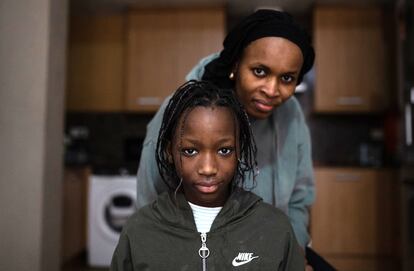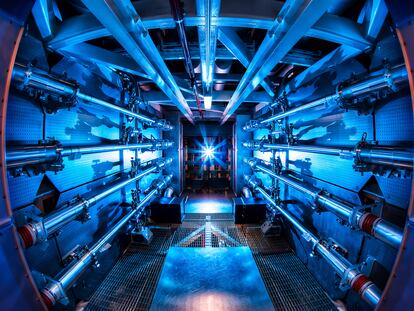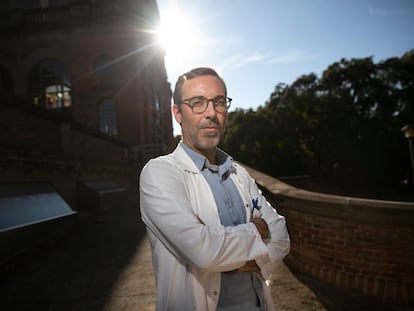A genetically selected baby saves her sister from a serious blood disease
Diama was born with sickle cell disease and needed a bone marrow transplant. Her parents underwent in vitro fertilization to select a healthy, compatible embryo and give birth to a child that could cure her

Diama Ndiaye’s tummy no longer hurts. Gone, too, are the constant hospitalizations that took her away from school for weeks and those terrible bouts of pain that could only be mitigated with a cocktail of medication. She is cured of the sickle cell disease with which she was born, a serious hereditary blood disease that can cause severe pain, mobility problems and a high risk of infections. “I’m recovered,” the 11-year-old girl mutters shyly in the living room of her house in Terrassa, Barcelona (Spain). Hopping around her, oblivious to everything, is her three-year-old sister Sokhna: she doesn’t know it, but she saved Diama’s life.
Sickle cell disease (also known as sickle cell anemia) was a sentence of endless pain and premature death: life expectancy with this disease is around 30 or 40 years. The only cure – the doctors explained to the family – was a bone marrow transplant from a matched donor, ideally a sibling. But Diama did not have one. Her parents, who wanted more children but were afraid of facing this hereditary disease again (both are carriers of the anomalous gene), entered a preimplantation genetic diagnosis program at the Sant Pau Hospital in Barcelona, consisting of in vitro fecundation with genetic selection of an embryo that was not affected by the disease and that, in this case, was also immunologically compatible with Diama. The idea was that the baby would be born free of the disease and, in addition, that blood samples could be taken from the umbilical cord and marrow in order to transplant them into the eldest daughter and cure her. It was a success.
Until recently, Diama had only known a life of constant pain. She was born with the disease, but it took her parents a while to find out, as they were not aware that they carried the gene that causes sickle cell disease. “She was born small and underweight, she was in pain, cried a lot and was frequently hospitalized,” recalls her mother, Oulimata Ndiaye, 33. Discomfort was a constant and her quality of life worsened steadily: the constant trips to the hospital made her miss class for weeks at a time and, at school, she could not go out into the yard during the winter because the cold caused unbearable pain in her bones.
Diama’s red blood cells were neither round nor oval. They looked more like a sickle or a crescent. The hemoglobin (the protein that carries oxygen in the blood) was abnormal and caused them to become misshapen and lose flexibility. Under these circumstances, the red blood cells have difficulty passing through the smallest blood vessels and can obstruct blood flow, causing damage to the tissues that are poorly supplied with oxygen. “These occlusive cases translate into a lot of pain and require hospitalization and even opioid treatment,” explains Ana Polo, director of the reproductive medicine service of the Puigvert-Sant Pau Foundation.
These occlusive crises can happen anywhere in the body, but they are especially frequent in the bones, which can end up destroyed and requiring a prosthesis. In her case, Diama suffered many “mesenteric vaso-occlusive crises,” explains Isabel Badell, director of the hematopoietic transplant unit of the Sant Pau pediatrics service. This means that the blood obstructions occurred in the layer of fat, through which the blood vessels that nourish the intestine circulate. This made her stomach hurt very much. “There is an area that the blood doesn’t reach well, it becomes necrotic and can cause a mesenteric infarction. When the patients are admitted, you have to overhydrate them and then give painkillers to varying degrees, until you get to the morphine-based ones,” explains Badell.
‘Would you like to have another child?’
Currently, there is little treatment against sickle cell anemia: some support medication, blood transfusions and substitutions, hospitalization with hydration and pain relievers. Not much else. The only curative treatment is a bone marrow or cord blood transplant, says Badell, who took over Diama’s case. “The best choice [of donor] is always a sibling, because it has a 90% success rate. Then there are the non-family donors, but success drops to 70% and there is a greater risk of rejection and graft-versus-recipient disease,” she explains.
The family, originally from Senegal, arrived in Barcelona in 2015 after living in the Spanish region of Navarre for four years. It was their pediatrician at the health center in Terrassa who referred them to Sant Pau, recalls Badell: “In this case there were no siblings, the parents were not compatible, and they had to look for a donor. So the first thing you ask them is if they would like to have more children and, if so, if they would like them to be compatible with Diama, for the transplant. And they said yes. The mother, who is very enthusiastic and energetic, said: ‘Now, now, now!’” laughs the pediatrician. But the process would be long.
A preimplantation genetic diagnosis can only be carried out in accredited reference centers. Everything is meticulously analyzed, especially if therapeutic purposes are also sought for third parties. In this situation, the National Commission for Assisted Human Reproduction assesses each case individually, as its authorization is required. Polo remarks: “This is not about making a medication baby. The first thing that parents are asked is if they would like to have another child, and if they say yes, that is when you suggest this option. But the purpose is not creating a child that they don’t want in order to save the other one.” Badell agrees: “I would never mention this, for example, to parents who are separated. Separated parents have already suggested it to me, but no. Not an object child,” she categorically censors.
Disease-free and “happy”
The process is not smooth, but rather like “an obstacle course,” says Polo. And quite long: on the first visit, in 2015, Diama was about five years old. The transplant was finally carried out last April, seven years later.
Before starting the preimplantation genetic diagnosis, a study is carried out on the couple to confirm that the woman has a good ovarian reserve and the man has normal seminal values. “Her age and weight are also important, so that the quantity and quality of the eggs is good,” adds Polo. Oulimata was 26 years old and had a good ovarian reserve, so the prognosis was favorable. Even so, the in vitro fertilization process is usually complicated, because not all the eggs that are obtained with the hormonal stimulation treatment come to term. Many never make it. “Some will not be mature; of those that are, when we add the sperm, between 60% and 80% will fertilize. From there, they will develop until day five of embryonic development and we will lose some in that time as well. We perform a biopsy of the embryos that are five days old in order to extract cells and analyze them genetically: we want them not to present sickle cell disease, to be compatible with leukocyte histocompatibility antigens [for Diama’s transplant] and not present any other alteration that makes the embryo incompatible with life,” says Polo.
The probability of finding a healthy, disease-free embryo that was compatible with Diama was 18%. In fact, despite the favorable prognosis for Oulimata, and after obtaining the approval of the National Commission for Assisted Human Reproduction, three cycles of hormonal stimulation were necessary to find a healthy and compatible embryo (there were some that were not carriers of the disease but were not compatible with Diama).
The selected embryo was implanted in Oulimata in 2018, and in September 2019 Sokhna was born. However, the blood from her cord was not enough for the transplant, so they had to wait for her to grow up to do a bone marrow extraction. Finally, in April 2022, the beginning of the end of Diama’s sickle cell disease came: after 11 years with it, the girl underwent a course of chemotherapy to remove her bone marrow (to prevent rejection); then, she had the transplant.
The eldest sister is now free of the disease. And “happy,” she says. For Oulimata, this process has been a double gift: “We had been waiting for eight years to get pregnant and then Sokhna arrived, who, it turns out, could also cure her sister. We are very happy,” she celebrates. And the family has grown even bigger: since the couple wanted more children, in 2021 Oulimata implanted two of the other healthy embryos that were preventively frozen during the in vitro fertilization process, and last July, Mouhamed and Aisha were born.
Tu suscripción se está usando en otro dispositivo
¿Quieres añadir otro usuario a tu suscripción?
Si continúas leyendo en este dispositivo, no se podrá leer en el otro.
FlechaTu suscripción se está usando en otro dispositivo y solo puedes acceder a EL PAÍS desde un dispositivo a la vez.
Si quieres compartir tu cuenta, cambia tu suscripción a la modalidad Premium, así podrás añadir otro usuario. Cada uno accederá con su propia cuenta de email, lo que os permitirá personalizar vuestra experiencia en EL PAÍS.
¿Tienes una suscripción de empresa? Accede aquí para contratar más cuentas.
En el caso de no saber quién está usando tu cuenta, te recomendamos cambiar tu contraseña aquí.
Si decides continuar compartiendo tu cuenta, este mensaje se mostrará en tu dispositivo y en el de la otra persona que está usando tu cuenta de forma indefinida, afectando a tu experiencia de lectura. Puedes consultar aquí los términos y condiciones de la suscripción digital.
More information
Archived In
Últimas noticias
Maduro pleads not guilty before the federal court in New York: ‘I am still the president of Venezuela’
A new test can detect Alzheimer’s from a finger prick
UN team enters Sudanese city of El Fasher after paramilitary massacre: ‘It’s like a ghost town’
A recipe for resistance: Indigenous peoples politicize their struggles from the kitchen
Most viewed
- Gilles Lipovetsky: ‘If you want to live better and fall in love, take Prozac, don’t look to philosophy’
- Alain Aspect, Nobel laureate in physics: ‘Einstein was so smart that he would have had to recognize quantum entanglement’
- Alvin Hellerstein, a 92-year-old judge appointed by Bill Clinton, to preside over Maduro’s trial in New York
- Maduro’s downfall puts China’s relationship with Venezuela to the test
- Why oil has been at the center of Venezuela-US conflicts for decades











































